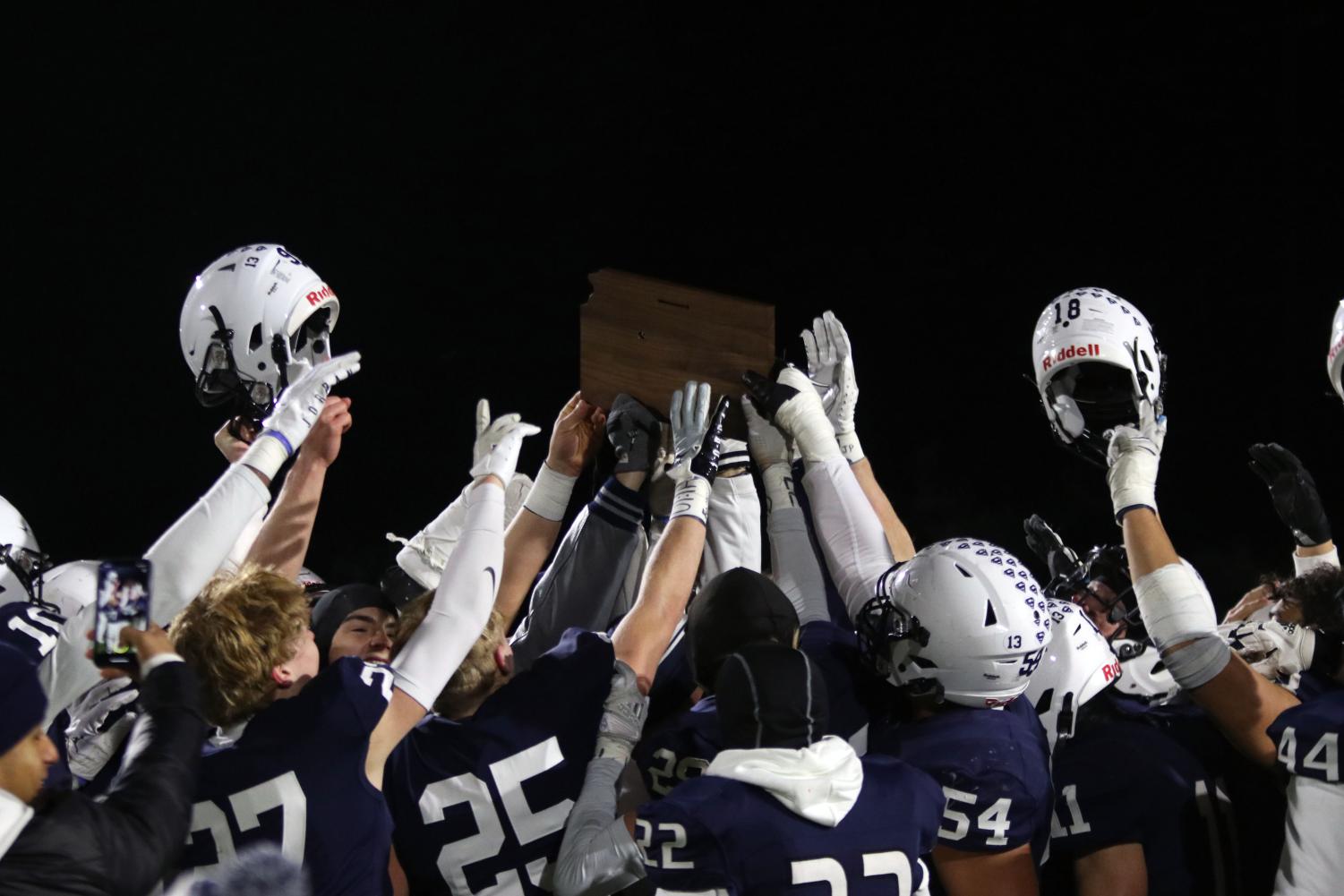Football team goes through rigorous weekly routine to pull off successful season
November 21, 2022
The cheers. The lights. The sound of Metallica’s “Enter Sandman” blaring over the Jaguar Stadium speakers. The football team, tightly packed against one another in the inflatable jaguar tunnel, wait in anticipation of rushing the field to the sound of a jaguar snarl. This is what a typical Friday night has looked like for the Mill Valley community every football season for the last several years. Now, with the Jaguars headed to their sixth state championship game in eight years, the team is looking to pull out another state win over rematch opponent Maize Saturday, Nov. 26. It’s no understatement that the student body goes above and beyond to support the football program on game day; however, as a community, we’re exposed to a small fraction of what goes into pulling off a championship-winning season. This is a week-long look at what goes on behind-the-scenes of the football program.
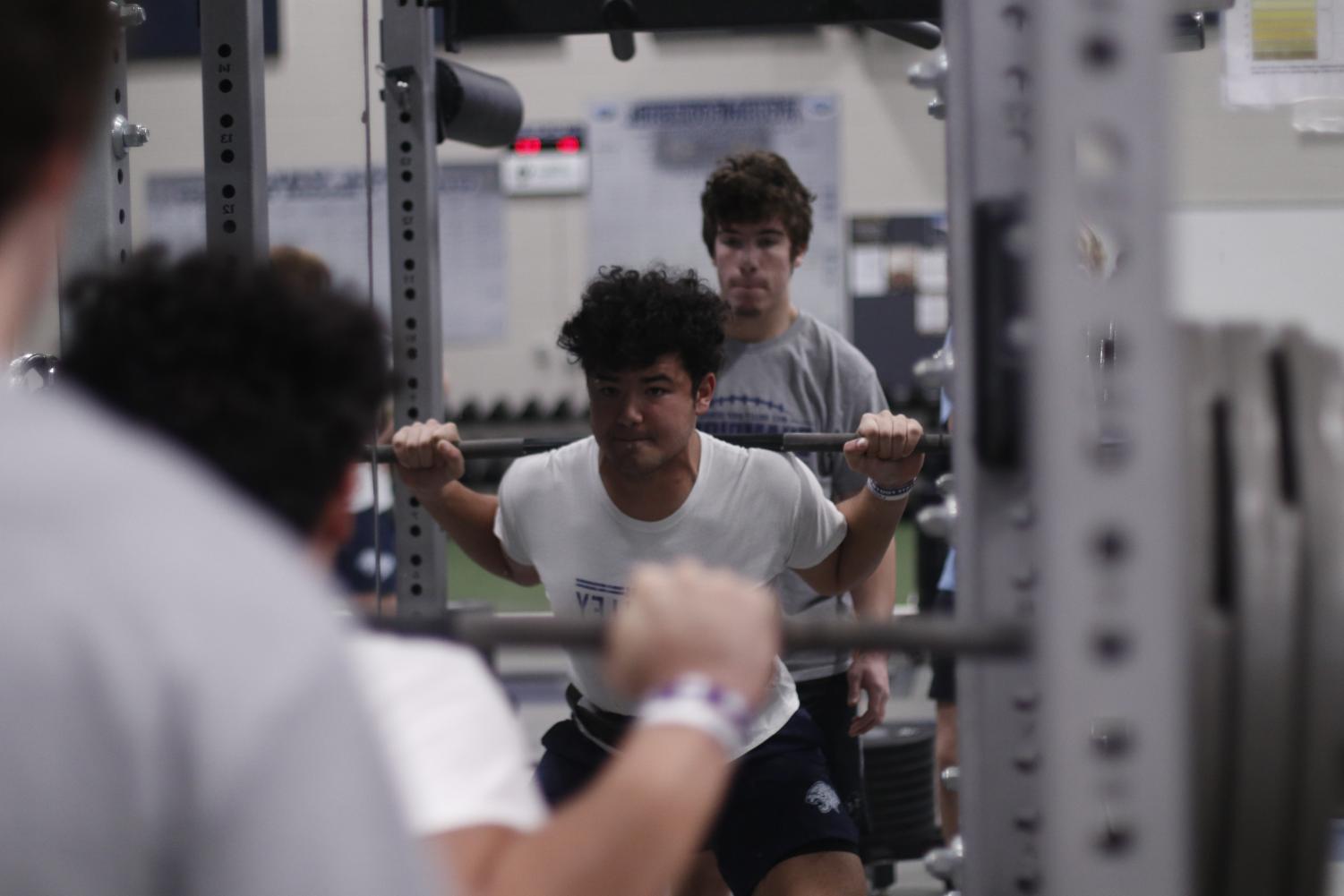
By Luke Wood
Squatting 335 pounds on his shoulders during the Zero Hour lift period, junior Truman Griffith progresses through his early morning strength training workout Monday, Nov. 14.
Monday
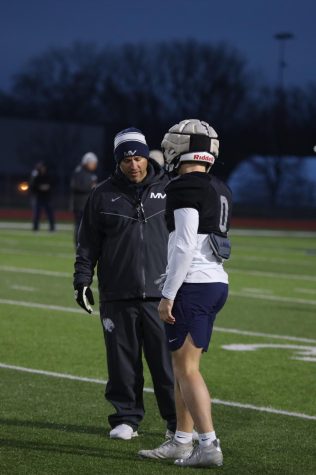
On Monday morning at 6:30 a.m., when most students are still sleeping or just crawling out of bed, weary-eyed football players are filing into the weight room to begin the first 40 minutes of their early morning. The team’s regular Monday and Friday morning lift period, called “Zero Hour”, is the official start to the new game-day week. Intense music fills the space of the weight room and main gym area as athletes grab for leg bands, weights and dumbbells to lead themselves through their regular Monday morning strength workout.
This early morning Zero Hour lift period takes football athletes through various strength and core exercises, building a sturdy foundation for the athletes to perform at a higher level come after school practice and game day.
The reason for Zero Hour’s early start time on Mondays and Fridays is to maintain a consistent, uninterrupted time for athletes to retain the muscle needed to be successful in a power sport as intense as football, according to defensive lineman coach Eric Thomas.
“Strength matters because all of the top teams lift. You can’t just haphazardly lift,” Thomas said. “You can be good if you decide to lift every once in a while, but you can’t be excellent. You have to put time in the weight room and a lot of teams just aren’t putting in that extra time like we are. Looking at our kids, you can tell that they lift and that goes a long way in a football game as well as for injury prevention.”
When 7:10 a.m. hits, Zero Hour finishes and the boys gather for a brief team meeting led by head coach Joel Applebee, where a day-by-day breakdown of the week is laid out and team goals are gone over for the upcoming Friday night game and opponent. Applebee prefers to lead this team meeting by going through a PowerPoint containing such details.
“We try to model as best as we can, whether it’s in practice, in a meeting or just outside in the community, the value of hard work, discipline and keeping a strong mindset of understanding making choices of what’s best for you,” Applebee said. “Whether those choices you make are right or wrong, in the end, you’re going to learn to move forward with those choices you’ve made.”
Following a brief punt meeting for the program’s special teams at 7:20 a.m., the team is dismissed for the morning to go to classes.
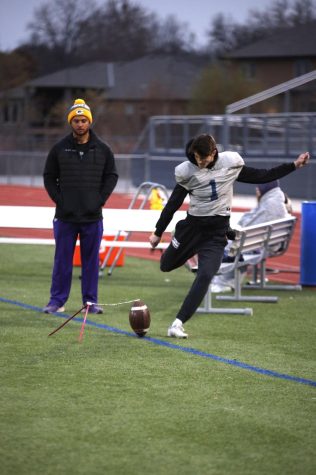
Come Monday afternoon, after school has ended for the day, the team returns and divides into their positional units to go over the week’s opponent scouting report, a report created by the coaches giving the team insight into what to expect from the week’s opposing defense.
Opponent scouting time is a cornerstone to the football program’s weekly routine, dedicating a little over an hour of the afternoon toward analyzing the week’s opposing gameplay schematics such as commonly run plays by the opposing offense and defense and assessing which plays are more predictable than others.
“The importance of watching all the film that we watch is being able to know our opponent’s moves before they do and making the correct play on our end to counter those moves,” Thomas said. “Our kids are really smart. In terms of our starters, they all know what to do. When we’re watching film and they see themselves they can almost immediately pick out what they did great and what may need a bit of work.”
Opponent scouting takes up a greater portion of team time spent off the field earlier in the week as some players, like quarterback senior Hayden Jay, take up to four pages of notes weekly on opponent schematics.
“All this time we spend scouting our opponent really just lays out what we, as the offense and defense, will be working on for that week,” Jay said.
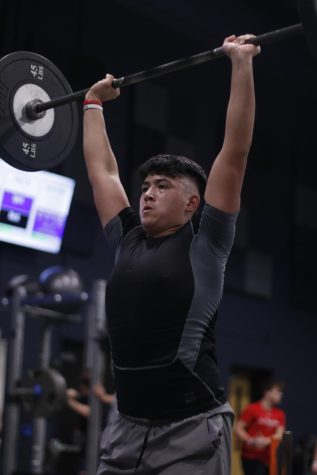
When scouting is finished, the team turns to reviewing their own film from the previous week’s game as athletes turn to critiquing themselves for the upcoming practice. Film review concludes at 4:15 p.m. at which the team is dismissed to suit up for after school practice.
By 4:30 p.m., practice begins on the field under the harsh cold weather recently brought on by the postseason; athletes are often dressed in warm layers, a stark contrast to what their practice wear typically looks like at the beginning of the regular season. Typically lasting shorter than practices for the remainder of the week, the team divides back into their positional units and runs a multitude of different plays and agility drills for Monday’s practice.
“All after school practices are divided into periods,” Thomas said. “In the first nine periods, which are four minutes each, we, as a defensive line, focus on technique which usually consists of a warmup. Then, we move into some type of crucial technique which deals with what plays we plan on running come Friday night. Later into practice, each position group focuses on different aspects of football where we do a walk through of what plays we’re going to do for that week’s game; that part varies for offensive and defensive players. Cycling through the different plays with our different strings of the offensive and defensive lines make up the rest of what a typical practice would look like.”
By 6:00 p.m., when the stadium lights have switched on to combat the sunset, the team is dismissed to go home for the evening.
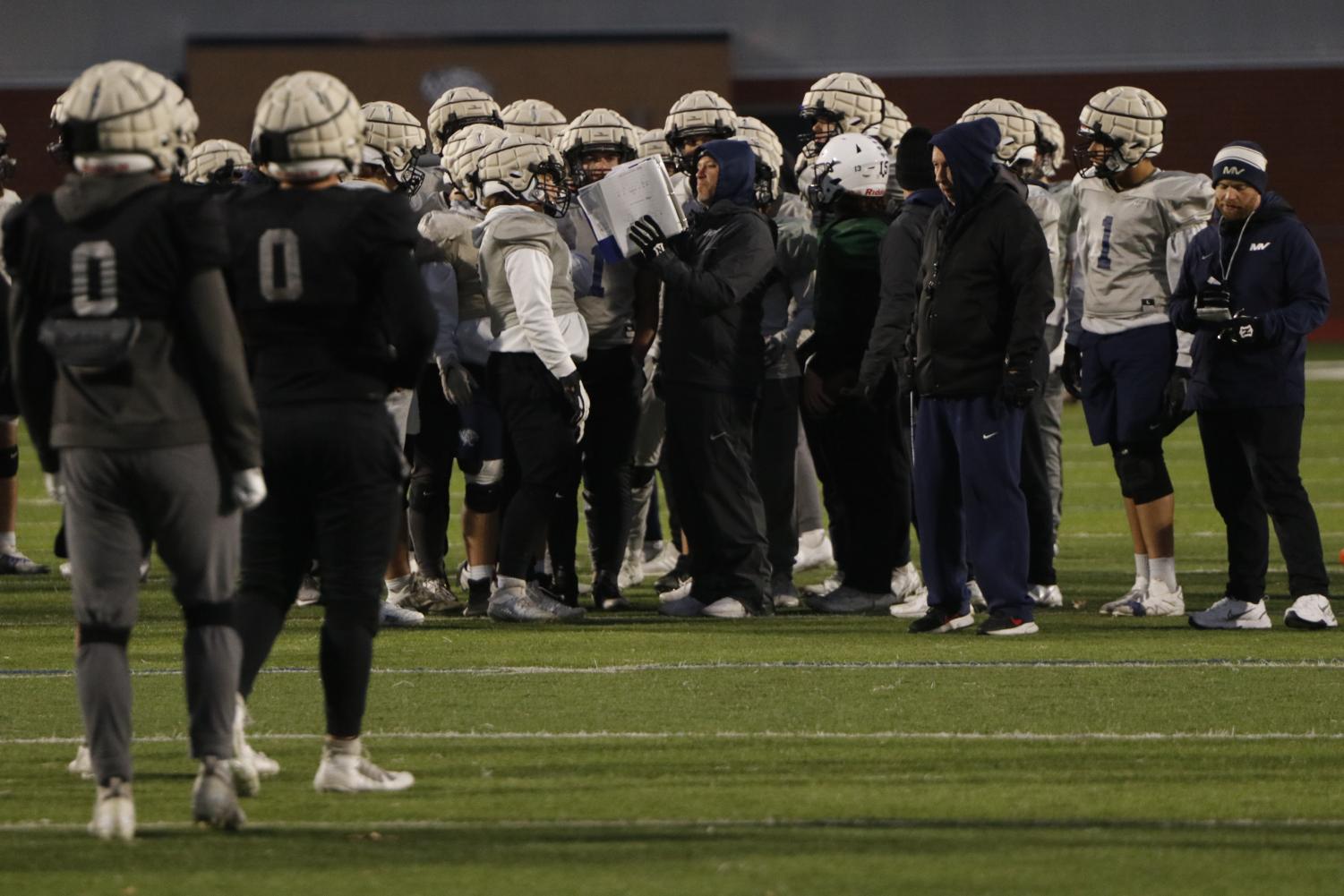
By Luke Wood
Leading the offense in play calling, coach Joel Applebee holds up the play book at practice Tuesday, Nov. 15.
Tuesday
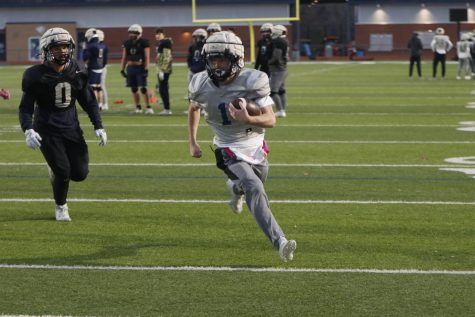
The arrival of Tuesday brings another early morning for the football team however athletes are not arriving early at school to lift weights. Tuesday mornings, as well as Wednesday and Thursday mornings, are reserved for reviewing practice film of the previous night. Football athletes, who are expected to be present for Monday’s practice film at 6:40 a.m., divide up by positional unit and relocate to different rooms to watch, analyze and dissect the previous day’s practice. Athletes are dismissed from film to attend classes at 7:20 a.m.
Depending on whether the school day is a blue or a silver day, football athletes will reconvene in the weight room at the start of first block on silver days for their in-school strength and conditioning weight class. According to Thomas and Applebee, the extra 90 minutes allotted during the school day for strength training and supplemental workouts provides consistency for athletes in maintaining stamina during after school practice as well as on game day.
“In the weight room is where it all starts,” Applebee said. “We want to build the best athlete we can build whether that’s explosiveness, flexibility, core or playability, all of those things come into play when we take that extra time in the weight room. I’m grateful to the school and our administration for allowing our team have that time during school on silver days to better ourselves athletically.”
Following the end of the school day, film review switches back to opponent scouting in the afternoon starting at 3:05 p.m. By 4:00 p.m., athletes head out to the field for after school practice suited up in full pads at 4:00 p.m. With the addition of practicing in full pads on Tuesday, athletes are able to run plays and drills from the previous night at slightly faster speed.
Leading up to Friday’s game, practice pace speeds up each day in order to have the athletes capable of executing a full run through of offensive and defensive plays come Thursday night’s practice.
The duration of Tuesday practices, as well Wednesday practices, last upward of two hours, accommodating for an earlier start time since the first hour and 10 minutes of Monday’s after school practice time is dedicated toward opponent scouting.
While athletes are dismissed to go home at 6:00 p.m., coaches stay back for another hour and a half to review film in the field house, going home around 7:30 p.m.
“The whole point of us coaches staying back to watch film together is make sure that we’re on the same page, both offensively and defensively,” Applebee said. “We make sure that we know of any corrections that need to be made so we can all be on the same page for the next day’s practice.”
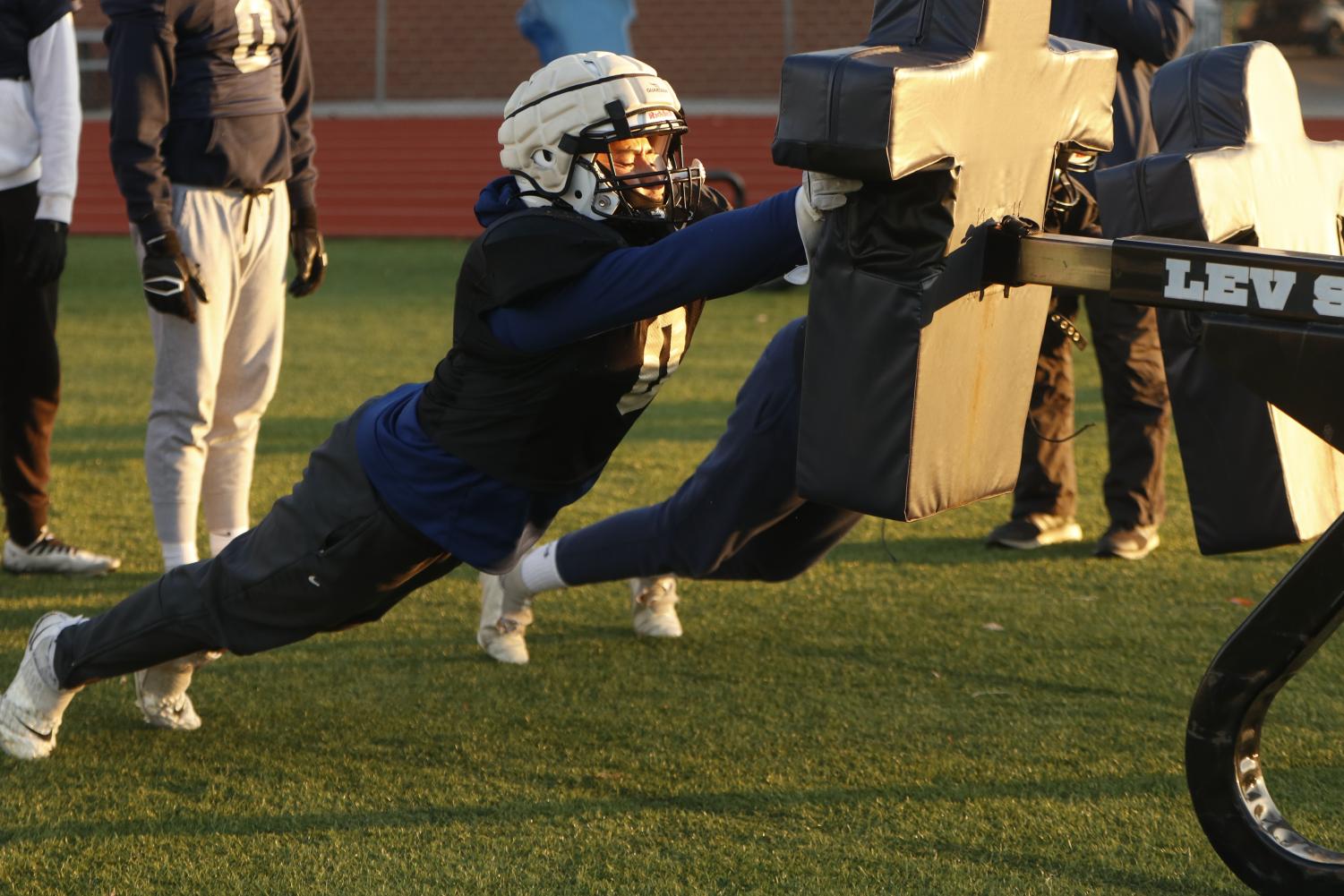
By Luke Wood
Pushing into the sled, defensive lineman Spencer Vaka works on his form during a drill Wednesday, Nov. 16.
Wednesday
Wednesday morning, when the clock hits 6:40 a.m., continues the series of watching practice film from Tuesday’s night practice, analyzing play schematics and setting goals for upcoming practice that evening.
Athletes, who leave for class at the regular 7:20 a.m. dismissal time, return to finish their film digest from Tuesday.
At this point in the week, practice starts running plays at half speed, slightly faster than a walk through from Tuesday’s practice. Through this consistent time spent with one another before, during and after school, football athletes are able to utilize practice time to perfect technique as well as grow in their bond with one another, according to kicker junior Kenten Laughman.
“Everyone has your back,” Laughman said. “Even after a missed kick, I just know that my boys are still going to be there on the sideline, they’re not losing faith in me, just like a family. We are here as a family and we have fun as a family. It’s just something really special.
The team’s bond proves to be a beneficial facet for many players on the team, especially wide receiver senior Hayes Miller, who recently transferred to Mill Valley from Palmyra, Missouri to “get a better experience in a football program” with new opportunities presented to him in “going from a smaller school to a bigger school.”
“It’s completely different in how close the football program is. You’re a lot closer to all the guys and everyone has a good time,” Miller said. “When it’s time to put in the work, you guys all put in the work together and it’s really just a fun environment to be in.”
Field practice resumes at 4:10 p.m. with athletes only wearing upper body pads. Regular practice concludes at 6:10 p.m. and athletes are sent home for the night while the coaches, staying back at the fieldhouse office, gather for an additional 90 minutes to review film of the day’s practice.
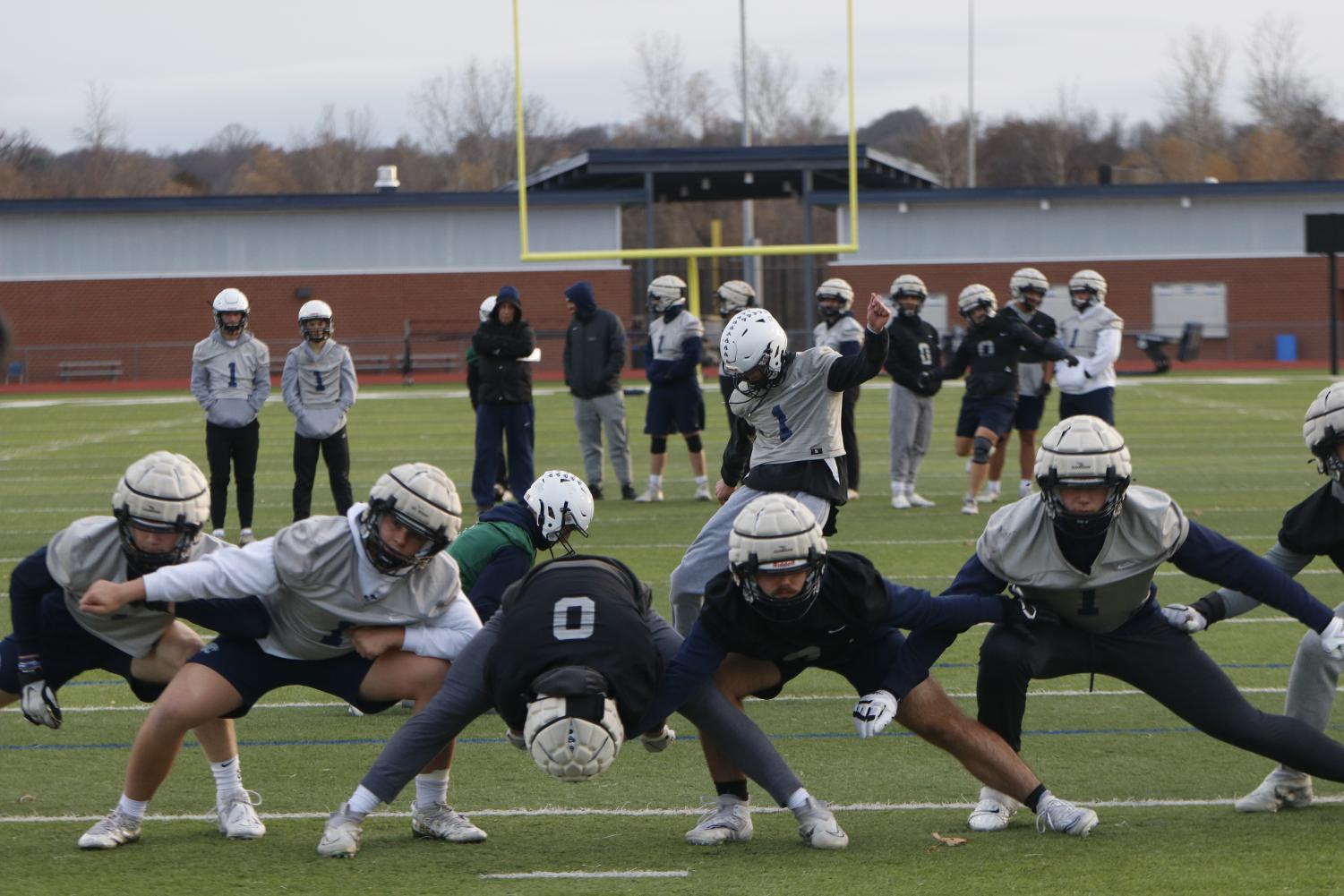
By Luke Wood
Once the ball is snapped, offensive lineman lean towards the center as kicker Kenton Laughman attempts to kick a field goal.
Thursday
The approach of Thursday, the eve of game day, brings about a slightly different practice routine. Football athletes arrive at school at the regular 6:40 a.m. time for film review of Wednesday’s practice in the morning and while, in the afternoon, athletes go straight to the field for practice at 3:30 p.m., helmets only.
Thursday afternoon practice is a full speed-run of all of the previous offensive and defensive plays worked on at practices earlier in the week
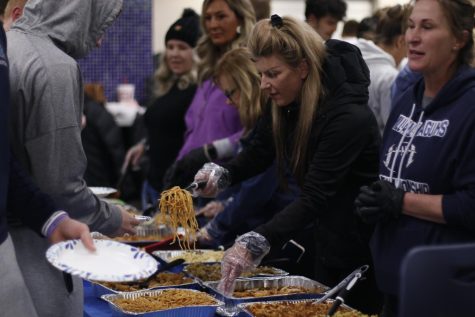
“Thursday practice is really just making sure that we’re polishing up all of the plays we’ve worked on all week and making sure we’re prepared,” Jay said. “It’s kind of like a pretest where you make sure you know all of the information you’re supposed to know. We make sure that we go over everything with everyone in special teams to make sure they are in line and ready to go for Friday night.”
Whilst regular practice is happening on the field, parents begin to arrive at the front of the school, their trunks full of pasta, salads and other high-carb foods, to begin setting up the main commons area for the team’s weekly pregame team dinner. Team dinners are planned and orchestrated completely by the parents.
At the conclusion of practice at 5:05 p.m., athletes, tired and hungry, rush to the locker room to change out of their practice gear and head to the main commons area to load their plates for their weekly team dinner.
Applebee designates the responsibility and uptake of planning team dinners to a group of parents who make up the team dinner committee. Within the committee, responsibility for planning team dinners rotates between groups of two to three parents, divided by class.
“Typically we’ll have senior parents plan the dinner one week, then junior parents another week, then sophomore parents and freshman parents follow those weeks after,” Applebee said. “What I’ve done is I’ve broken down everything we do in our program, like team dinners, into committees. Thankfully, by parent volunteers, we are able to keep those different committees running.”
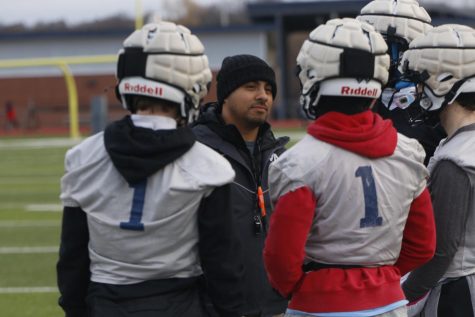
Delectable scents and smells of freshly cooked food fills the commons upon the arrival of the football team from Thursday afternoon practice. Lines are formed, plates are loaded and stomachs are filled as the exchange of conversation and laughter consumes the next hour and half of the evening.
Miller cherishes the extra time pregame dinners allow for him to grow closer with his teammates.
“It’s just a great opportunity to talk with each other and become closer to my teammates and become more of a family.”
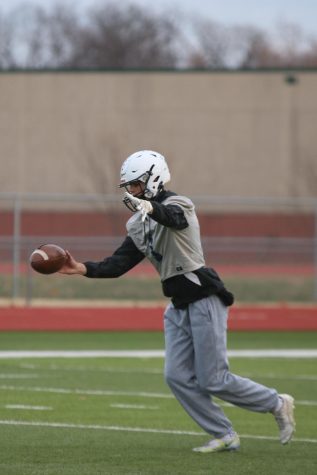
Athletes are given a small window of time between the end of their pre-game team dinner and 7:20 p.m. to get their homework done, supplementally review film on their own time and wind down for the evening before returning to school to have their separate offensive and defensive team meetings.
“Our separate offensive and defensive meetings go over the same things our team meetings go over,” Jay said. “It’s more of a verbal walkthrough of what Friday night will look like.”
Offensive and defensive team meetings lead right into a full team meeting at 8:00 p.m., the final team meeting of the week before game day before athletes are sent home for the night to rest up for game day.
All program members, freshmen through seniors, pack the weight room to revisit goals for the week set forth at Monday morning’s team meeting and listen to a motivational speech given by a local veteran.
“Mr. Deerwester comes in every Thursday night to speak to us,” Jay said. “He has been around the game of football for a really long time so he’s got a lot of wisdom for us. The whole point of our Thursday night meetings is to calm us down and keep our minds focused on the right things.”
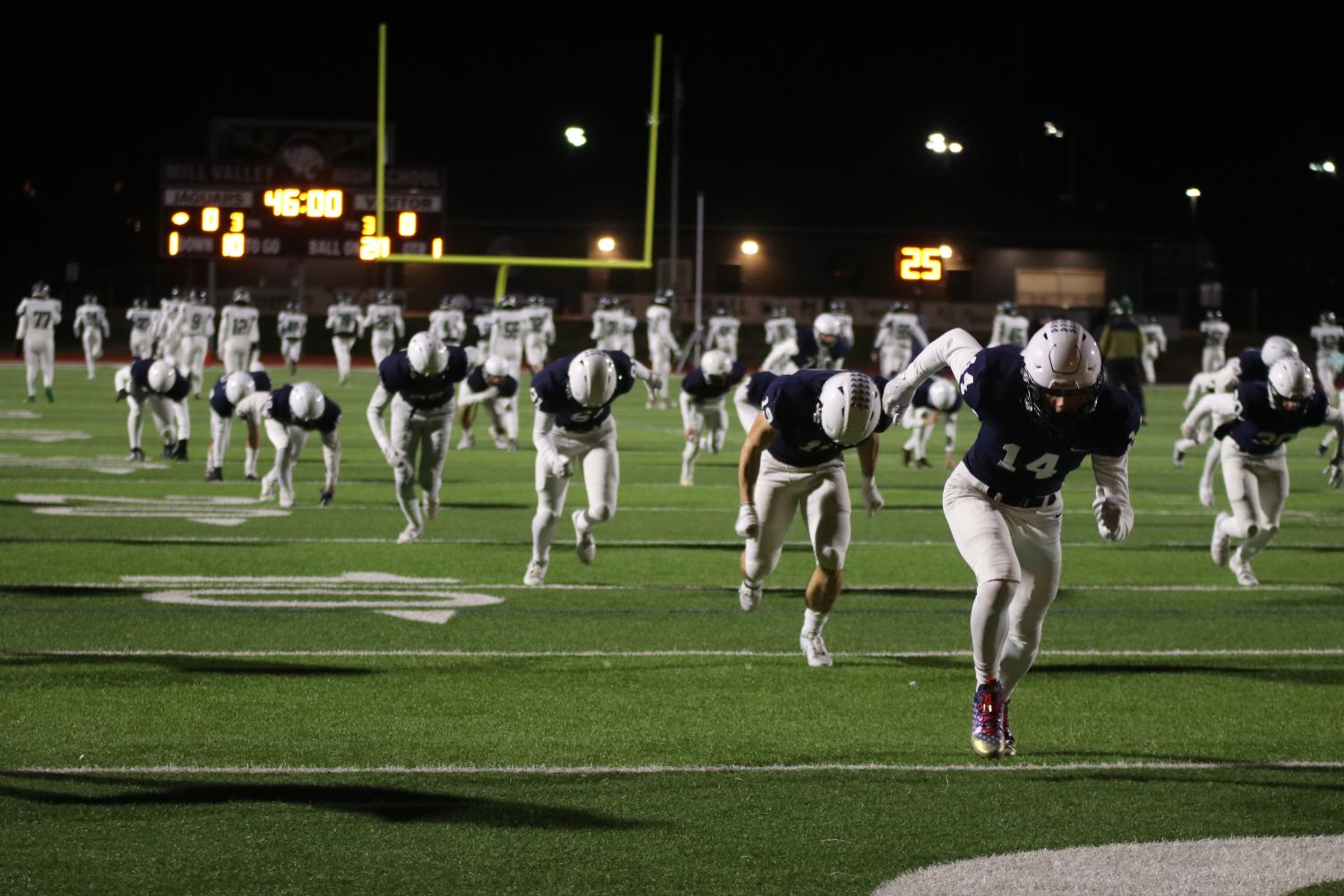
During pregame warmups, the football team sprints to the end zone before their 5A sub-state game against Blue Valley Southwest Friday, Nov. 18.
Friday | Game Day
Friday is finally game day. In the morning from 6:40 a.m to 7:10 a.m, players start the day with their gameday Zero Hour lift period. Afterwards, they have a regular school day where they are expected to put just as much work into their education. For Applebee, success on the field starts off the field.
“We really want to make sure they understand that if they’re doing their best in the classroom, doing their best outside of school in the community, the success on the football field will take care of itself,”Applebee said.
Nevertheless, there is no shortness of work put in to have success on the field. The dedication of the players on the field stood out even more to running back senior Sidney Lockhart after his injury.
“Everyone’s dying out there on that field.” Lockhart said, “It’s really something to be grateful to have as a team.”
Mill Valley’s football program stands out from other programs because of this committed mentality. The players and coaches don’t shy away from the hard work needed to achieve success. Resulting in a dedicated atmosphere that can be felt by Laughman before a game.
“Some people are getting locked in, some people are turning up, getting excited.” Laughman said. “But everyone’s just ready to go. It’s the best time of the week.”
Athletes are given a brief deadtime between when school gets out until 3:50 p.m., where players get taped before the game to prevent turf scrapes that may result during gameplay. From 4:40 p.m. to 5:05 p.m., football athletes will have a “lights out” period, a focus period before the game to make sure everyone is in the right headspace. For Miller, this is an important step in the pre-game ritual to ensure the team can work as a unit.
“[We] get a chance to think about our brother next to us and what we’re going out there for and who we’re fighting for,” Miller said, “And we’re fighting with one another and know that we have to be the best we can be. So we can succeed as a family.”
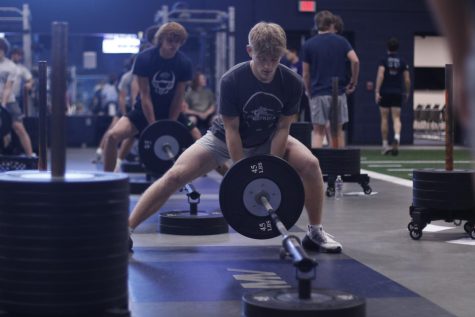
The pregame routine continues with a meeting in groups by their position to go over any last minute specific details and a subsequent reconvenement time for the team to come together for the traditional “Jag Walk.”
Walking from the weight room, down the main hall of the school and exiting out through the school’s west doors leading to the football field, the football team, bundled in layers upon layers, make their way to the locker room through a tunnel of cheering parents.
Following warm ups, a team stretch and a static stretch period, the players file back into the locker room one last time to say a prayer as a team.
“That time spent in the locker room gives us a chance to think about our brother next to us and what we’re going out there for and who we’re fighting for,” Miller said. “We’re fighting alongside one another to know that we can be the best we can be and succeed as a family.”
Then 6:50 p.m. roll around, when it’s time for the team, lead by Applebee and flag carrier defensive back Mikey Bergeron, to walk up to the Jaguar tunnel and wait for their que to rush the field. By the time the National Anthem, school fight song and coin toss are complete, it’s game time at 7:00 p.m, the time where all the work throughout that week and the previous weeks, comes together.
More details on the Jaguars’ 63-0 sub-state win over Blue Valley Southwest Friday, Nov. 18 can be read here.
For senior Kate Hendrix, who has been one of the football team’s managers since freshman year, game time means continuing to help the team in any way she is able to.
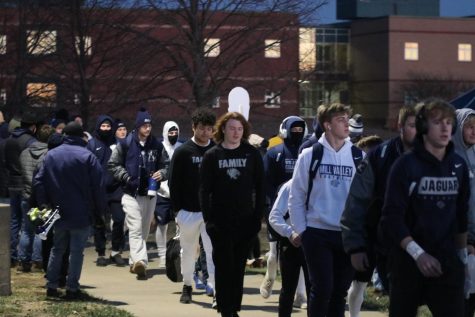
“We are there to provide for them and help them do better throughout the week so that on game days,” Hendrix said, “They can put their best foot forward and we’re just kind of there to back them up and support them throughout [games].”
One of the roles the managers have is to film both practices and games. In order to make sure the team can effectively utilize the film for review, they must make sure to get all the players in the play which requires precision whether they are using the drone or directly on the sidelines.
Overall, it takes many moving pieces to have such successful games on Friday nights that requires major effort from a lot of people. Not only from players and coaches, who are spending over 20 hours a week practicing and reviewing plays, but also from managers, athletic trainers and parents who are there to support the program throughout the season.
The Jaguars will face off in a 5A state rematch against Maize Saturday, Nov. 26.
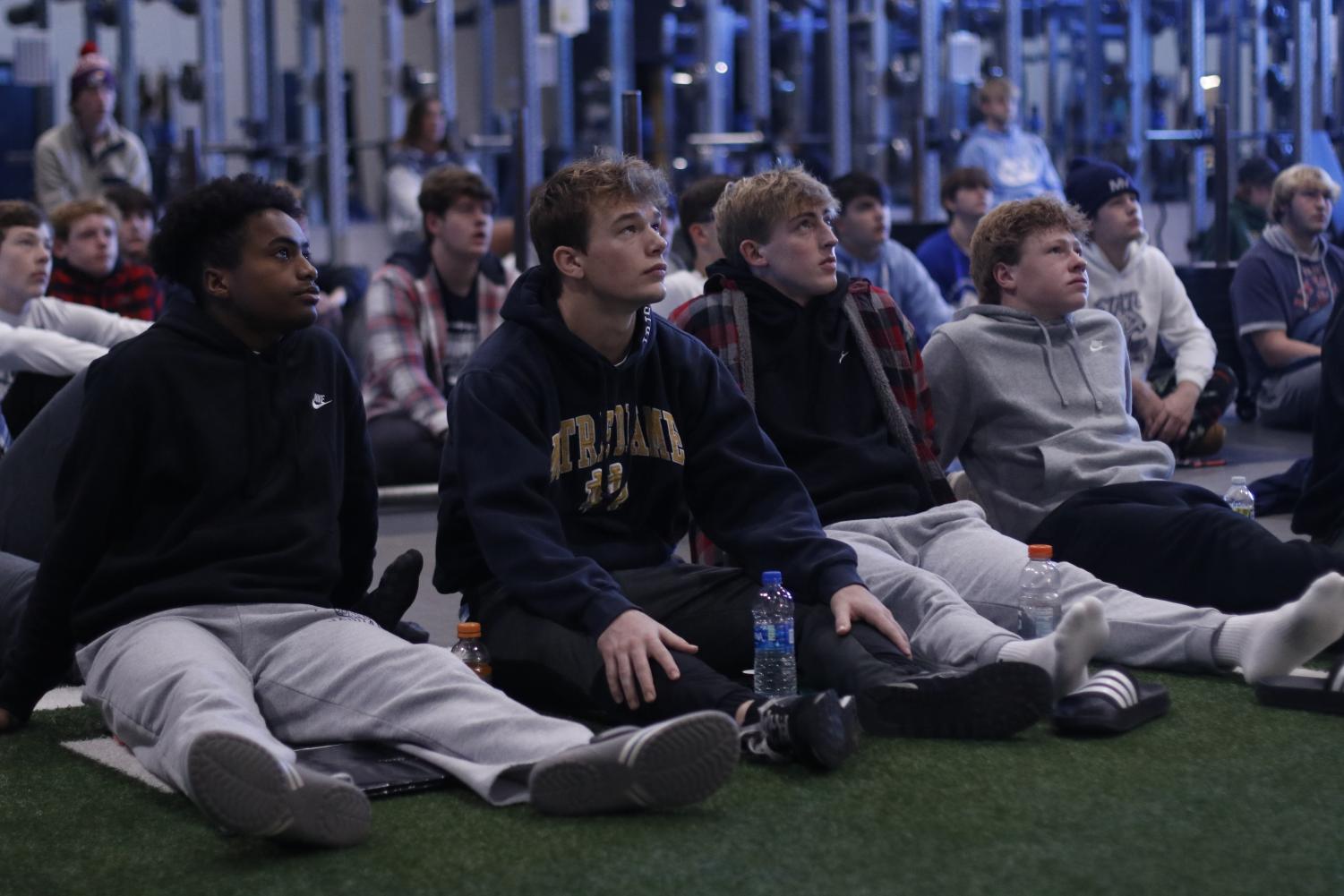
By Luke Wood
Looking up at the film screen, seniors Baruch Hasabu, Hayes Miller, Hayden Jay and junior Garrett Cronin review a video of a punt return.
Saturday
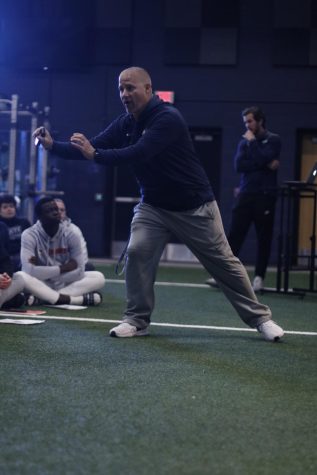
The week is not over on Friday, even after success on the field. The continuance of taking part in film watching is an integral part of success for the team during their post game routine laying down a solid foundation for the upcoming week. Jay and Miller view
Saturday morning film as a way to grow from past errors.
“For the other teams, we can dissect what they’re doing and just see their tendencies and on all the things that we can, just see what they’re doing and [what] we can take advantage of.” Miller said, “And then when we watch our practice film, we’re just critiquing ourselves and trying to do better than what we have previously.”
Film watching is how the team starts Saturday morning from 8:00 a.m. to 9:45 a.m. Applebee also uses this as a way to highlight what went well during the games.
“We get to start out all together, get the special teams and then we’ll break up in position groups and go watch the night befores game and break [the game] down.” Applebee said, “What we did good but also we did bad”
Not only is Saturday the time to learn from the previous game but for offensive coordinator and quarterbacks coach, Michael Strack, preparation for next week’s game also starts Saturday morning.
“Usually by Saturday morning, we’ve gotten our opponents [film] and so I start by watching that. I spend several hours on Saturday, just watching their games. Same thing on Sunday.” Strack said, “Then I usually get up here to the school around noon and work on my own and then we meet as a staff from three to six or seven in the evening.”
After the coaches meeting they will have a plan in place of what they want that Friday’s game to look like as well as a game plan of plays and routes they need to prepare for throughout the week.
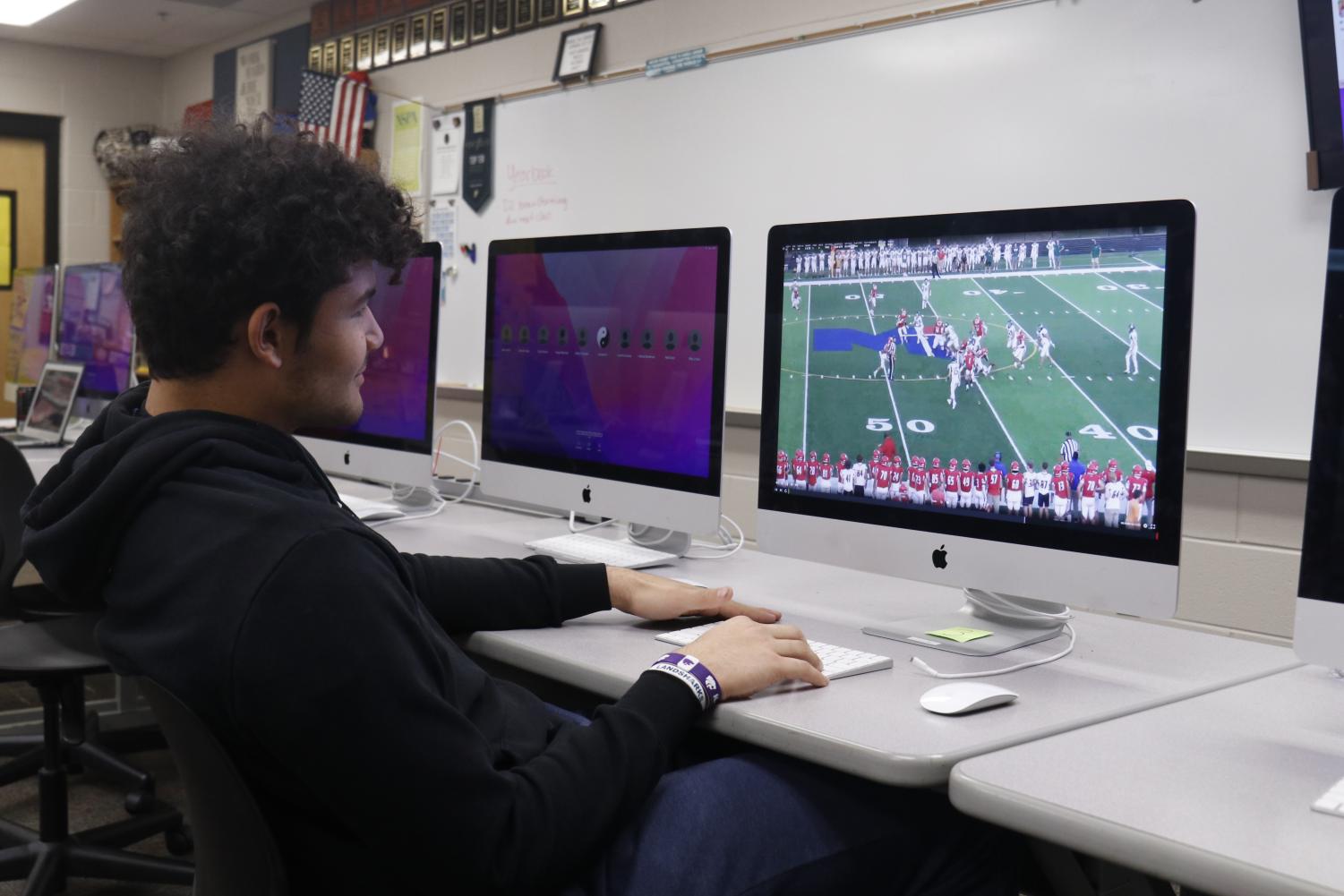
By Luke Wood
Junior Truman Griffith reviews game film from a previous opponent during seminar Monday, Nov. 14.
Sunday
Come Sunday, players have earned a well-deserved day off from weights training, conditioning and practice before restarting their weekly routine on Monday to prepare Nov. 26’s state game. For Laughman, he is able to catch up on everyday activities other people can take for granted.
“I normally watch some football, hang out, do everything I wish I could do in the week,” Laughman said. “And just definitely relax.”
Coaches, on the other hands, meet at the field house at 3:00 p.m. to get started on planning practice in anticipation of next week’s game. In this case, Applebee will be preparing his coaches to lead the team through one last week of practice before the football team’s season concludes for the final time this year.
“Us coaches usually meet at the field house Sunday afternoon and discuss how the upcoming week is going to look,” Applebee said. “What we do with one another on Sunday ranges from putting together and sending out the week’s practice schedule to the team so that they know what to expect from the week or putting together my PowerPoint for Monday morning’s team meeting. Regardless of what it was that we’re accomplishing, it’s important that we all have that time on Sunday to get going for what’s going to happen on Monday.”
Players may also watch more film with one another or do drills and workouts during this time.
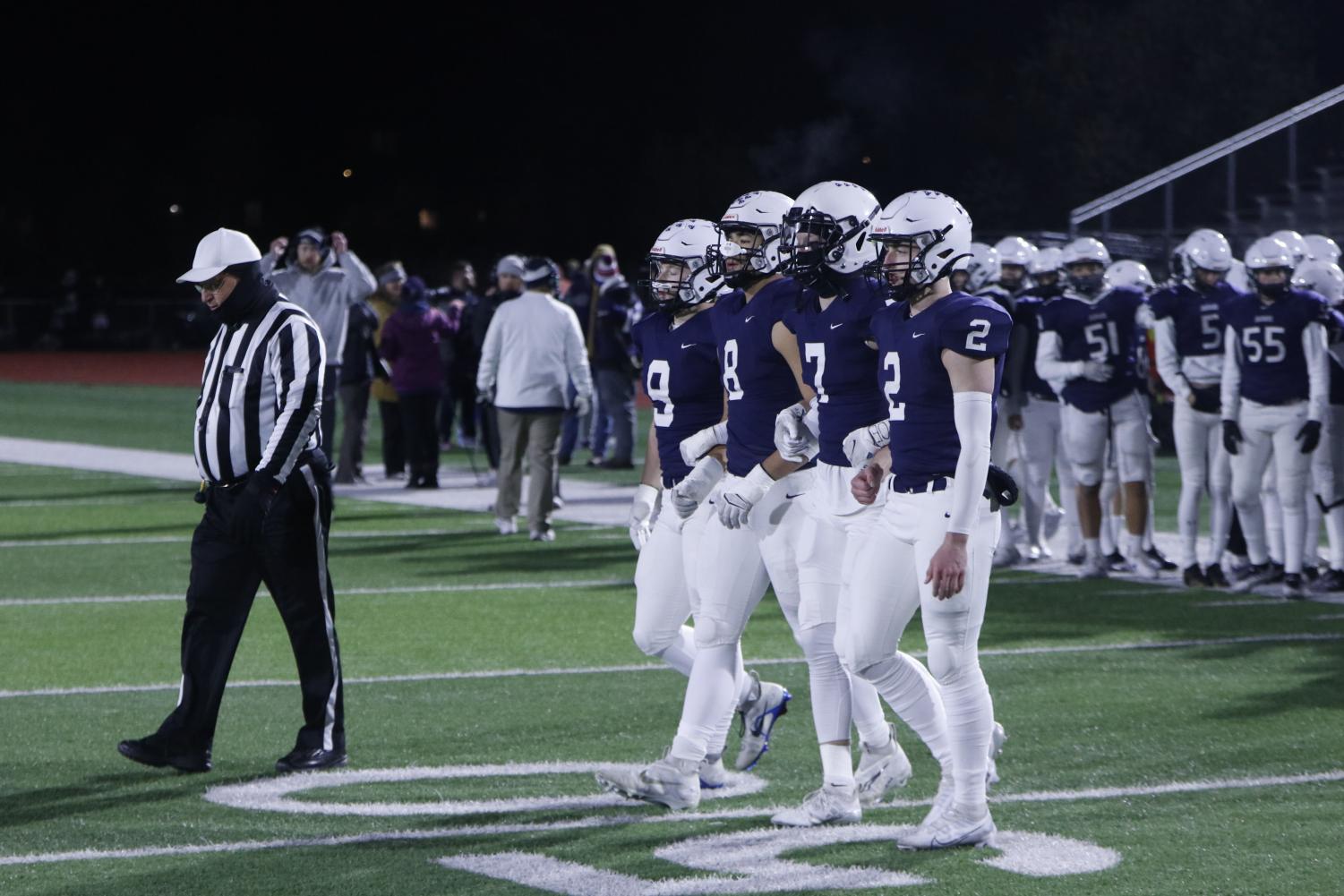
By Luke Wood
Walking out to the captains meeting, seniors Noah Coy, Mikey Bergeron, Hayden Jay, and junior Truman Griffith lock arms.
Conclusion
As a whole, coaches and staff within the program are dedicated to turning their athletes into the best and most well rounded versions of themselves. Miller believes that is what makes the program so successful, on and off the field.
“It’s something that consumed a lot of your time, but it’s all worth it.” Miller said, “It gives you a great amount of joy and fulfillment doing something that’s going to help you become a better person and a better athlete.”
A packed schedule with early mornings and late nights allows the players to learn discipline. Strack hopes those skills will transfer over to a successful future.
“Eventually you will see some measure of success,” Strack said, “I think that’s really important in life, because [success] doesn’t happen right away in life. And so I think they get that from our program as well.”
Growing together, and succeeding together builds a bond within the team, turning the football program into a family. For Lockhart it is this unity that allows them to achieve great success.
“I think that really does create a bonding experience that we have and the chemistry that we need to have a D1 culture to win those games,” Lockhart said. “We may not be the biggest people out there the fastest, the strongest, but we know what it’s like to fight with our brothers and win a battle.”
